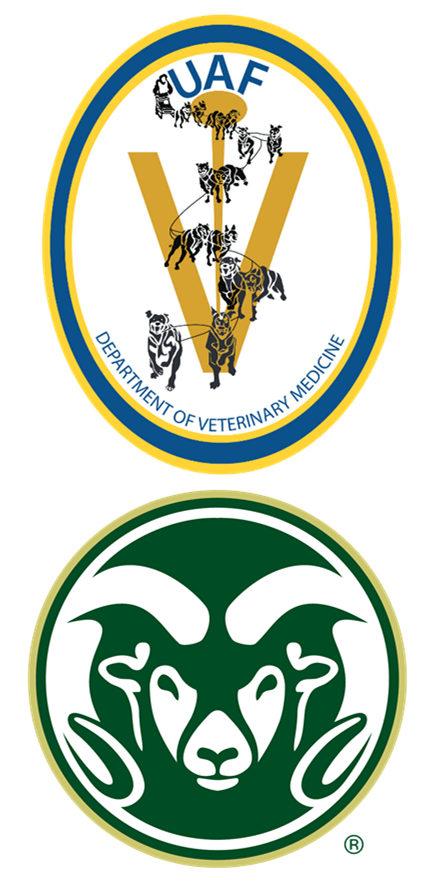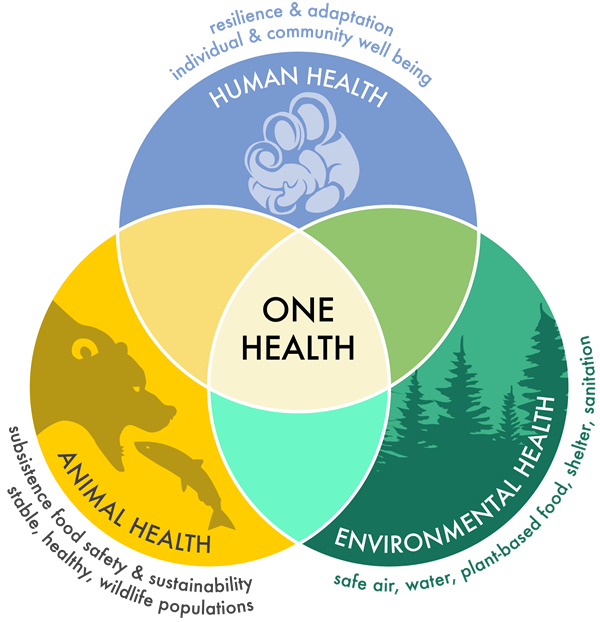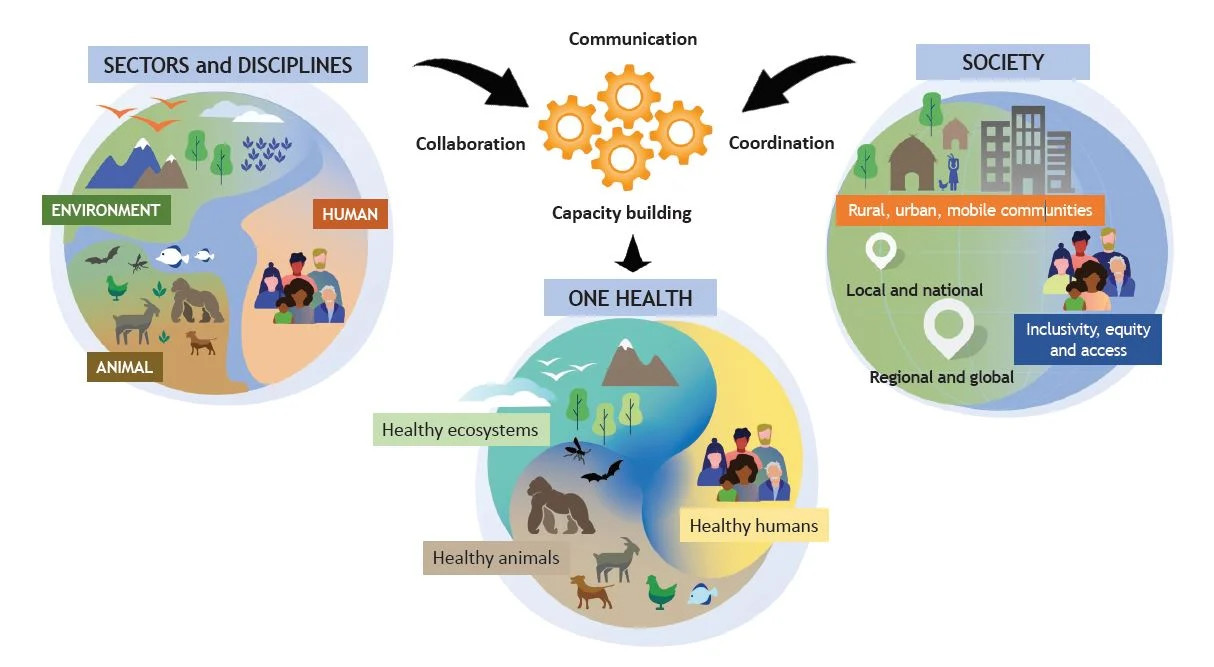About Us
UAF/CSU Collaborative Veterinary Medicine Program
The Doctor of Veterinary Medicine (DVM) graduate degree program at UAF is a 4-year collaborative program with Colorado State University (CSU).
UAF DVM students complete the first two years of their education on the UAF Troth Yeddha campus in Fairbanks, AK then move to Fort Collins, CO to complete their final two years on CSU's campus, learning from veterinarians representing 28 different board-certified specialties and gaining hands-on experience at the state-of-the-art James L. Voss Veterinary Teaching Hospital. UAF/CSU DVM students ultimately receive their diploma from CSU.
The UAF course curriculum for the first two years of instruction match the course curriculum and objectives offered to first and second year students on the CSU campus and provides the same academic rigor, but courses are slightly altered for our unique environment. Some courses make limited use of distance education to deliver content from specialists at CSU. Think arctic and subarctic climates, muskox, reindeer, sled dogs, and other unique experiences and information our surroundings, community, faculty, and staff have to offer!
Mission Statement
The Department of Veterinary Medicine (DVMed) at the University of Alaska Fairbanks (UAF) provides high quality education, research and service in veterinary medicine and the biomedical sciences. Faculty from several disciplines work collaboratively under the One Health paradigm, striving for combined optima in human, animal, and environmental health.
One Health Concept
 What is One Health?
What is One Health?
One Health is an integrated, unifying approach that aims to sustainably balance and optimize the health of people, animals, and ecosystems. It recognizes the health of humans, domestic and wild animals, plants, and the wider environment (including ecosystems) are closely linked and inter-dependent.
The approach mobilizes multiple sectors, disciplines, and communities at varying levels of society to work together to foster well-being and tackle threats to health and ecosystems, while addressing the collective need for clean water, energy, and air, safe and nutritious food, taking action on climate changes, and contributing to sustainable development.
The One Health paradigm forges collaborations between animal, plant, environmental, and human health arenas. ex: chemical, engineering, and social scientists, dentists, nurses, agricultural/horticulturalists and food producers, wildlife and environmental health specialists, veterinarians, and many other related disciplines that fall under its purview.
One Health at UAF
One Health at UAF has grown into its own department with the mission to: improve our research capacity and more effectively promote well-being in the North, build teams to create research, education, and outreach programs around One Health, and create long-term funding opportunities through collaboration.
The concept of “One Health” has been considered an important context for the Department of Veterinary Medicine as the development of a program which includes teaching, research and service for the University of Alaska Fairbanks (UAF). Many institutions have adopted this philosophy and some have tried to put this into practice. An article by Zinsstag et al. (2011) addresses this complex approach and this one page summary tries to place aspects of their review into an Alaska context to help form the foundation for veterinary medical training (articulated 2+2 program), biomedical sciences research (basic and applied health research), human and health management and research, and veterinary professional services (e.g., continuing education, consultation) as integrated together.
Zinsstag et al. (2011) emphasizes the drivers and linkages that constitute the need for a “One Health” paradigm include 1) challenges of complex patterns of global change, and 2) awareness and inevitable interconnection of humans, domestic animals (e.g., pet animals, livestock), and wildlife (including feral domestic species) with their social and ecological environments. This requires integrated approaches to human and animal health research and application (practice) and their respective social and environmental contexts. Zinsstag et al. (2011) points out integrative thinking of human and animal health is not novel but has been considered in early historical times [e.g., Comparative Medicine (e.g., similar cellular processes of pathogenesis for humans and animals) at the end of the 19th century; Calvin Schwabe coined the concept of “one medicine” in the 20th century; concept of laboratory animal based biomedical research for human health benefit is omnipresent]. This requires an appreciation that human and veterinary medicine disciplines contribute to the development of each other; including their associated basic biomedical sciences. The recognition of this history is important as described by Zinsstag et al. (2011) in that “large portions of human and animal health thinking and actions still remain in separate disciplinary silos.” This would indicate work is still to be done, including at the UAF. Zinsstag et al. (2011) and our Group emphasizes that “integrative thinking is increasingly being considered in academic curricula, clinical practice, ministries of health and livestock/agriculture and international organizations.” This is where a progressive UAF must be in the biomedical sciences; and the Department of Veterinary Medicine can formally initiate this process to the benefit of Alaska. We face unique high latitude and marine (ocean) animal and human health issues in a changing environment that should motivate progressive approaches that include “One Health”.
Initiatives have recognized at least the human-environmental connection at the UAF – including aspects of sustainable development [e.g., Resilience and Adaptation Program, Alaska INBRE (environmental agents of disease)]. Challenges remain, however, because »large gaps in the curriculum, human medicine, veterinary medicine, etc. limit our capacity to develop this much needed area of expertise. The Department of Veterinary Medicine will begin to fill some of these needs. Zinsstag et al. (2011) provides another example when they state “analogous to “systems biology” which focuses mostly on the interplay of proteins and molecules at a sub-cellular level, a systemic approach to health in social-ecological systems (HSES) is an inter- and transdisciplinary study of complex interactions in all health-related fields.” The key to this is a scientifically rigorous approach applied to determine “emerging properties and determinants of health that may arise from a systemic view ranging across scales from molecules to the ecological and socio-cultural context”. The human and animal residents of Alaska should be considered in this “One Health” perspective above all other states because of our intensive relationship with and dependence on the “environment”.
Citations: Zinsstag, J., E. Schelling, D. Waltner-Toews, M. Tanner. 2011. From “one medicine” to “one health” and systemic approaches to health and well-being. Preventive Veterinary Medicine 101 (2011) 148– 156



